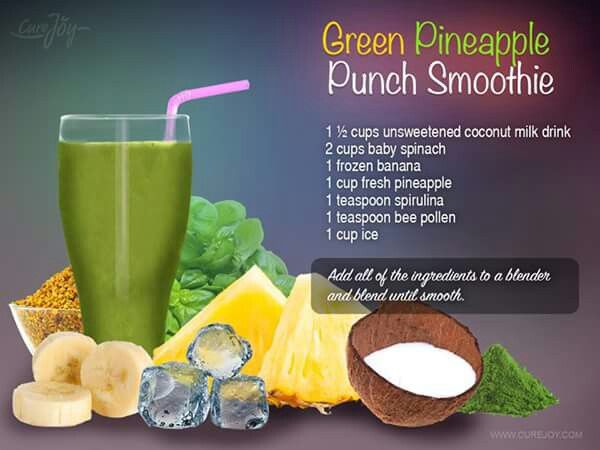Man boob baby feeder
Dads can finally ‘breastfeed’ with this wearable device
Breastfeeding can be a beautiful experience, but there’s no denying the unique toll it takes on moms’ sleep and stress levels. Most nursing moms have had the experience of being awake breastfeeding at 2:30 in the morning and looking over scornfully at their snoozing partner and his useless man chest. Now, a Japanese tech company is aiming to change that and to make infant care more equitable with a set of plastic “breasts” that allow dads to nurse their babies too.
The Father’s Nursing Assistant is a breastfeeding device manufactured by Dentsu and unveiled at the 2019 South by Southwest Festival in Austin, Texas. The wearable feeding machine is designed to resemble a woman’s breasts, and it comes complete with a large tank for storing breast milk or formula and a flexible plastic nipple.
The device was designed with input from pediatricians and caregivers in order to mimic the breastfeeding experience as closely as possible.
As an added bonus, the Father’s Nursing Assistant can also sense the baby’s feeding and sleeping time, which it then sends to an app so parents can easily track and analyze their baby’s schedule.
The nursing assistant has made a big splash on social media, where it recently started trending, despite the fact that it was originally unveiled in March. In the comments section of a video about the product on Yahoo Now Tech, dozens of parents chimed in to express confusion and dismay.
“OMG…I would seriously divorce my husband for wearing this,” one commenter wrote. Another added, “I’ll say it … fathers are not supposed to form this bond.”
But many others pointed out that this device actually has the potential to truly benefit not only breastfeeding moms but also solo dads and mothers who have undergone mastectomies or other medical treatments that make breastfeeding difficult or impossible.
In a press release, Dentsu representatives noted that the main goal of their product is to get dads more involved in carrying out child care duties.
“Much of the parental stress and difficulties surrounding childrearing are related to feeding and sleeping, and generally the rate of participation by fathers tends to be low,” the press release notes. The Father’s Nursing Assistant’s mission is to “decrease the amount of burden on mothers and increase the amount of time infants sleep by enabling fathers to breastfeed.”
A study published in 2019 in the journal Sleep showed that, on average, new mothers lose about an hour of sleep per night during the first three months postpartum. Meanwhile, fathers lose sleep too, but only an average of about 13 minutes per night. A separate 2015 study published in the Journal of Marriage and Family found that the birth of a new baby increases a mother’s workload by 21 hours per week, while dads’ workloads only increase about 12.5 hours.
The burden of infant care disproportionately falls on moms, and when a mom is also breastfeeding, it can seem like there’s no way to truly achieve balance.
Breastfeeding devices for dudes might seem like a step too far, but it’s hardly a negative for a tech company to be investing in ways to help fathers be more active and involved.
It’s also worth noting that this isn’t the first breastfeeding device that’s been devised for dads. In 2018, Marie-Claire Springham, a college student in the UK, won the grand prize in the Meaning-Centred Design Awards for her “chestfeeding” kit. The kit actually requires men to take the hormones progestin and domperidone to stimulate their own milk production. While “chestfeeding” and the Father’s Nursing Assistant may seem a little too much like science fiction, we have to give props to the innovators who are working to make parenting better and more equal for everyone.
Like what you're reading?
Join Care for FREE
EmailEmail is required.
Click 'Next' to start an account and get tips, tricks and trending stories.
Already Registered
The email address you entered is already registered. Would you like to log in?
Log in
Almost done!
Join Care for FREE
Create a free account to access our nation wide network of background checked caregivers.
First name
First name is required.
Last name
Last name is required.
Zip codeZip code is required.
We're sorry, your request could not be processed at this time. Please click here to try again.
By clicking "Join now," you agree to our Terms of Use and Privacy Policy.
Welcome to Care!
You're on your way to finding someone your family will love.
Start now
Male Breastfeeding Kit Allows Dads To Feed Their Babies
A male breastfeeding kit that allows dads to feed their babies is on the way.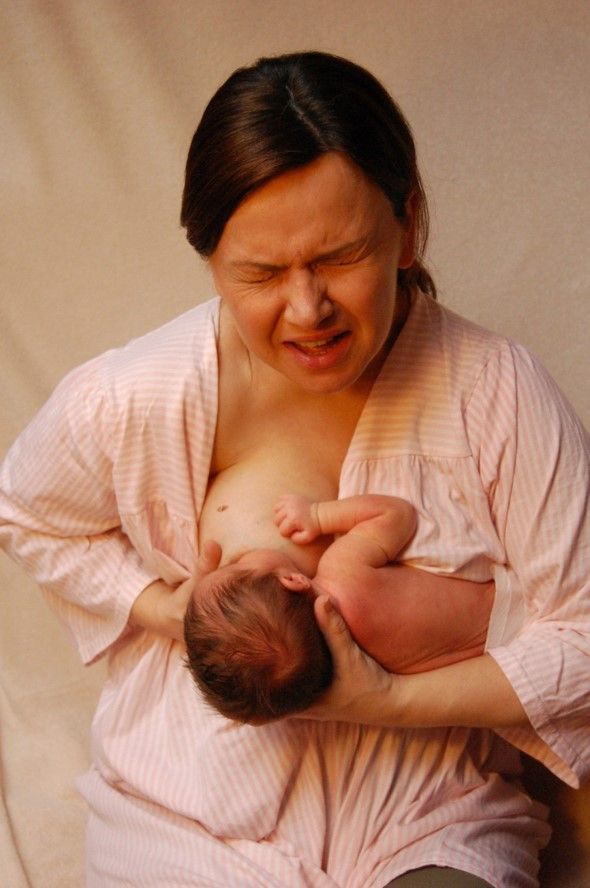
For dads, breastfeeding is one area of baby care they’re not equipped to handle.
But, thanks to a British project design student, future dads can take over nourishing their babies.
Designer Marie-Claire Springham says she invented the ‘chestfeeding kit’ after learning the most common trigger for postnatal depression in mothers is the pressure to breastfeed.
Springham says:
“This project began when I learnt about the code of silence that surrounds the issue of mental health and new parents.
“I was shocked to learn that over half of women experience emotional problems postnatally or during pregnancy and that new fathers also often suffer, experiencing feelings of exclusion and a fear of being ‘unable to cope’ ”.
How Does The Male Breastfeeding Kit Work?
The ‘chestfeeding’ kit was Ms Springham’s final year university project and is still in the concept stage.
That didn’t stop it from recently being crowned the winner of the world’s first Meaning-Centred Design Awards.
The dad-to-be takes a hormone once a day, beginning as soon as he knows his partner is pregnant.
This hormone is progestin, a synthetic form of progesterone.
It stimulates production of the milk-producing glands needed for breastfeeding.
Six weeks before baby’s arrival, dads then adds another hormone called domperidone.
This hormone stimulates prolactin, the hormone that triggers milk production.
The dad-to-be must continue to take this hormone cocktail for as long as he wishes to breastfeed.
Ms Springham based the drug regimen on information she gleaned from forums.
She noted the experience of trans people, who reported taking similar hormones to bring on lactation.
According to Ms Springham, suckling a baby would have the same effect on dads as on mums.
When a baby latches onto the nipple, it produces another hormone, called oxytocin.
Ms Springham says men’s nipples would likely need more stimulation than women’s.
That’s the reason she has included a pump in the chestfeeding kit.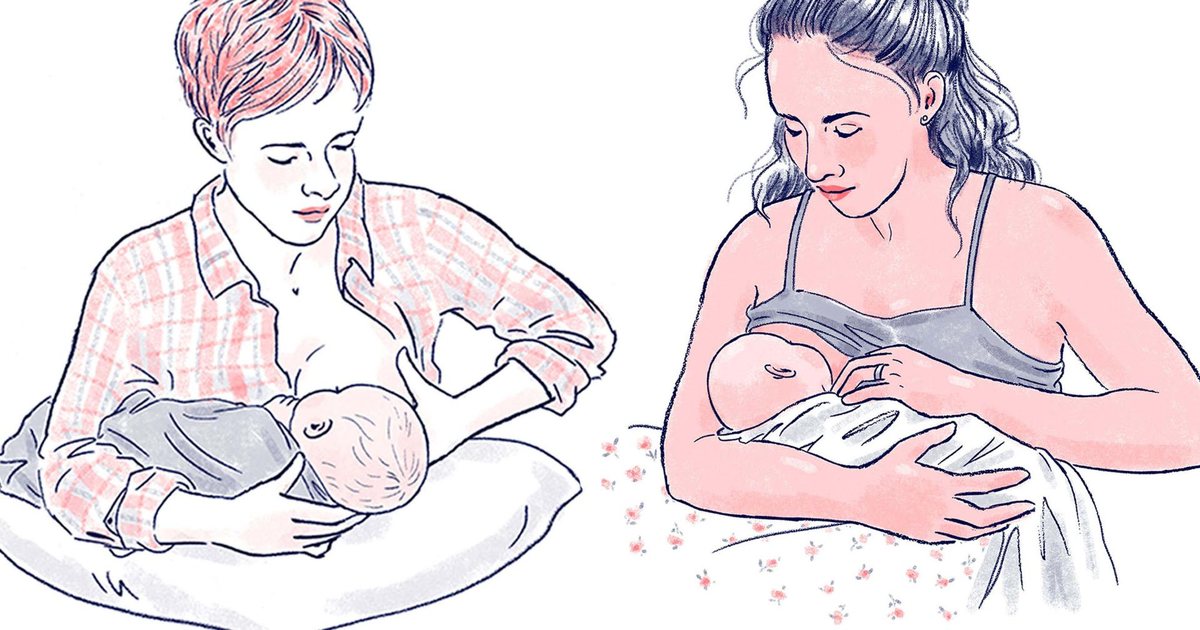
There is also a compression vest, which is the male equivalent of a maternity bra.
Is A Male Breastfeeding Kit Safe?
The male breastfeeding kit sounds great in theory.
However, what isn’t clear is whether Ms Springham has investigated the effects of the prolonged use of female hormones by males.
Female hormones, such as progesterone, are rarely used by men, except to treat medical conditions, including testicular cancer or prostate enlargement.
The reason? Female hormone treatment suppresses the production of testosterone in men.
The hormone testosterone is responsible for the development and maintenance of male sex characteristics.
When female hormones suppress testosterone levels, men might experience changes that affect the physical state and function of their sex organs.
Changes include:
- Shrinking of the testicles
- Lowered sperm count
- Erectile dysfunction
- Decreased sex drive.
Domperidone has a host of side effects, and has been linked to a heart rhythm problem
Men might also develop breast tissue and enlargement of their nipples after taking these medications.
There is also the potential for side effects similar to those women experience when taking the contraceptive pill; these include bloating, headaches and mood swings.
Do Men Naturally Lactate?
Have you ever wondered why men have nipples?
In the first few weeks of development, male and female embryos follow the same path.
This involves the development of nipples.
Around 6-7 weeks gestation, the embryo develops external genitalia.
If the embryo is male, the nipples are already in place, and remain.
Interestingly, males of many different mammalian species have the potential to lactate.
Only one species has the ability to do so spontaneously: the Dayak fruit bat of Southeast Asia.
In human beings, both men and women have breast tissue.
Women have mostly fatty tissue, milk glands and ducts.
In men, there is only a small amount of breast tissue, which is mostly fat, with a few ducts and some connective tissue.
The important ingredient in lactation, however, is prolactin.
This is the hormone produced by the pituitary gland. It stimulates the mammary glands to produce milk.
Spontaneous lactation in human males can occur, but only under certain conditions:
- Scientists documented lactation in male WWII prison camp survivors, who had experienced months of starvation. After receiving proper nutrition, the men’s hormone-producing glands rebounded far more quickly than their livers (which normally metabolise hormones), resulting in hormonal spikes that caused lactation.
- Liver cirrhosis can induce lactation by interrupting the normal metabolism of hormones
- Drugs, such as certain antipsychotics, can affect the pituitary gland, stimulating it to overproduce prolactin
- Pituitary tumours or other problems affecting the pituitary gland or hypothalamus, can also cause lactation.
Do Women Need Men To Be Able To Breastfeed?
Ms Springham added:
“The kit has the power to take what we thought we knew about parenting and turn it on its head, breaking down the strict gender and societal roles we have created for new parents”.
On one hand, breaking down strict gender and social roles is attractive.
What breastfeeding mother hasn’t been up in the middle of the night, staring furiously at her sleeping male partner and his worthless nipples?
On the other hand, wouldn’t it be better to support women to breastfeed?
For millennia, women have breastfed and evolution has had no problem with it.
From the late 1800s until recently, however, breastfeeding hasn’t been so popular.
It wasn’t ‘the done thing’ if you could afford infant formula, and was discouraged by medical professionals.
Even today, women face incredible bias and discrimination about the normal way to feed a baby.
Women are biologically designed to breastfeed. Mostly they want to, but often struggle, and are left without support.
Eventually the pressure becomes extreme and something has to give. Usually it’s a woman’s mental health.
Springham sees the male breastfeeding kit as “an empathy tool that enables dads to take a more active role in the first six months of the baby’s life and allows moms to relinquish some of the pressures and duties of parenting”.
In the first days after birth, a breastfeeding mother requires time to get her supply established. Having someone else to take over feeding undermines her ability to continue to breastfeed.
BellyBelly’s lactation consultant, Renee Kam, says about the male breastfeeding kit:
“This really misses the point. The focus should be on reducing the many hurdles to breastfeeding women face, and on improving breastfeeding support for women; this will enable more women to reach their breastfeeding goals”.
Is A Male Breastfeeding Kit A Good Idea?
Under certain circumstances – for example, in same sex male couples or when a mother has a double mastectomy – male breastfeeding might be the most appropriate solution.
However, while the male breastfeeding kit is still only an idea, we have no research to show breast milk from hormone induced lactation is safe for babies.
Do we know what consequences this could have for developing babies and their short and long term health?
We also have to consider the results of men taking female hormones for long periods of time.
What impact would it have on their own health and on their relationships?
And what about the ramifications if the male partner took over breastfeeding and was unsuccessful in maintaining supply?
Until these questions are answered, we should focus on supporting more women to breastfeed rather than undermine them.
Human donor milk and wet nursing are other alternatives to maternal breastfeeding that health experts and research support as the next best thing to mother’s milk.
Recommended Reading:
- Blokes, Boobs & Breastfeeding – Why Your Support Is Critical
- 7 Ways Partners Can Provide Great Breastfeeding Support
- Donated Human Milk – Why It Should Be The First Alternative For All Babies
Rules for breastfeeding - Budgetary institution of the Khanty-Mansiysk Autonomous Okrug - Yugra
Breastfeeding Rules The correct positioning of the baby to the breast greatly facilitates feeding, ensures the flow of milk, helps prevent inflammation, cracked nipples, and engorgement of the mammary glands.
How to feed a baby.
|
Programming, development of a version for the visually impaired - Internet laboratory "Delissimo"
This site uses cookies. They allow you to recognize you and receive information about your user experience. If you do not want your data to be processed, you must leave the site. If you continue to use the site, you GIVE CONSENT to the use of cookies, the processing and storage of your personal data.
Ok, I agree
Different positions for breastfeeding
Try different positions for breastfeeding to find the one that works best for you and your baby. You can see the options in our selection of photos
Share this information
There is no right or wrong way to hold the baby while feeding
, and mom and baby are sure to find their favorite position.
It is important that both you and your child feel comfortable. 1.2 It's good to learn a few different breastfeeding positions and techniques because life's circumstances often require us to be flexible, especially as your baby gets older and you start to leave the house more often.
Whatever position you choose to breastfeed your baby, remember a few simple rules.
- Prepare everything you need before feeding, including drinks, food, mobile phone, TV remote control, book or magazine. And do not forget to go to the toilet - the feeding process can take a long time!
- Make sure your baby is comfortable. Whichever position you choose, it's important to keep your baby strong, level, and provide good support for their head, neck, and spine.
- You should also be comfortable. Don't stress. If necessary, use pillows of different sizes or rolls of towels to support your back or arms.
- Make sure your baby is latching on correctly.
 Proper grip is the key to comfort when breastfeeding.
Proper grip is the key to comfort when breastfeeding. - If your baby does not latch on well or you experience pain while feeding, contact a lactation consultant for help. The specialist will also be able to show you how to hold your baby more comfortably.
1. Relaxed feeding or reclining position
The relaxed feeding position, also known as biological feeding, 1 is often the first position for most mothers. If, immediately after birth, the baby is placed on the mother’s chest or stomach, normally, he instinctively reaches for the breast and tries to grab the nipple. This phenomenon is known as the breast seeking reflex. Skin-to-skin contact stimulates the infant's feeding instinct, and gravity helps him to latch onto the breast and maintain balance.
But not only newborns can be fed in the reclining position - this position is great for babies of any age. It can be especially helpful if your baby does not latch well in other positions or does not like to be touched during feeding, and also if you have too much milk flow or too large breasts.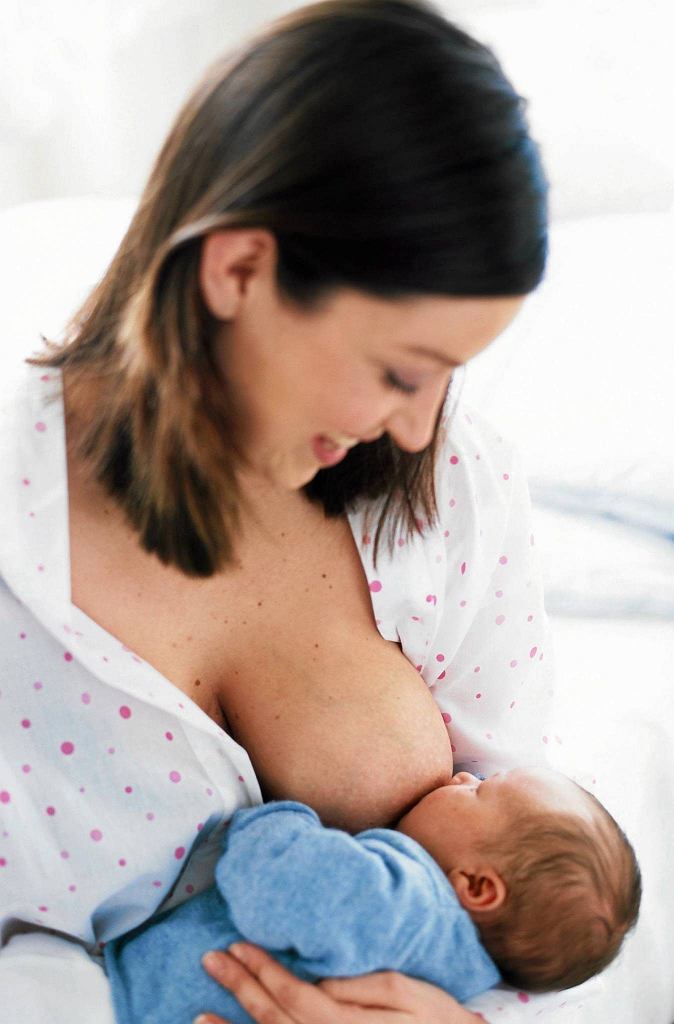 Isabelle, a mother from the UK, shares her experience: “I had large breasts, and the baby was born small - 2.7 kg, so it was not easy to find a comfortable position at first. After a few weeks, it became clear that there was no “correct” posture for me. As a result, I most often fed lying down, putting the baby on my chest. ”
Isabelle, a mother from the UK, shares her experience: “I had large breasts, and the baby was born small - 2.7 kg, so it was not easy to find a comfortable position at first. After a few weeks, it became clear that there was no “correct” posture for me. As a result, I most often fed lying down, putting the baby on my chest. ”
It is more convenient to feed not lying flat on your back, but half-sitting, leaning on pillows. So you will have a back support and you will be able to watch the baby during feeding.
2. Cradle position
This is the classic
first thought of breastfeeding. Mom sits straight
, and the baby lies on her side on her arm, pressing her stomach against her stomach. 3 Although this is a very popular position, it is not always easy to master with newborns because it gives the baby less support. Try putting a pillow under your back, and put a special breastfeeding pillow on your knees and lean on it with your hands. So you can more reliably support the child, without overstraining your back and shoulders. Just make sure that the baby does not lie too high on the pillow for feeding. The breast should remain at a natural level so that the baby can grab it without effort, otherwise sore nipples cannot be avoided.
Just make sure that the baby does not lie too high on the pillow for feeding. The breast should remain at a natural level so that the baby can grab it without effort, otherwise sore nipples cannot be avoided.
“I breastfed in the cradle position because it suited me perfectly! It was comfortable and I loved just sitting and looking at my little one,” recalls Rachel, a mother of two from Italy.
3. Cross Cradle
This breastfeeding position looks almost exactly like the cradle, but the baby is on the other arm. 3 This gives baby support around the neck and shoulders so he can tilt his head to latch on. This position is great for breastfeeding newborns and small babies, as well as for babies who do not latch well. Since the baby lies completely on the other hand, it becomes easier to control his position and you can adjust the chest with your free hand.
Julie, a mother of two from the UK, finds this position very practical: “I usually breastfeed my youngest in the cross cradle position. So I have a free second hand, and I can take care of an older baby at the same time. ”
So I have a free second hand, and I can take care of an older baby at the same time. ”
Do not hold the baby by the head at first, otherwise you may inadvertently press his chin against his chest. Because of this, the child will not be able to take the breast deeply, because the nipple will rest against the base of the tongue, and not against the palate, which will lead to inflammation of the nipples. As the child grows, this position becomes more comfortable, and he can rest his head on your palm (as shown in the photo above).
4. Underarm breastfeeding
In this position, also known as the "ball grip", the mother sits and the baby lies along her arm at the side, legs towards the back of the chair (or any other seat). 3 Another comfortable position for newborn breastfeeding, you can give your baby good support, full control of the position and a good view of his face. And the baby feels safe in close contact with the mother's body. This position is especially good for those who have had a caesarean section or a premature birth, as well as mothers of twins and women with large breasts.
“When I breastfed my first daughter, I had very large K-sized breasts—twice the size of her head,” recalls Amy, an Australian mother of two. - I put rolls of towels under each breast, because they were very heavy, and fed my daughter in a pose from under the arm, but only sitting straighter so as not to crush her. This position was also convenient because I had a caesarean section and could not put the baby on my stomach.”
5. Side-lying position
The side-lying position is ideal for relaxed
feeding at night in bed or on the couch. If you had a
caesarean section or ruptures during childbirth, this position may be more comfortable than sitting down. 3 In this position, mother and baby lie side by side, tummy to tummy.
“It was difficult for me to sit during endless night feedings, firstly because of the caesarean section, and secondly because of lack of sleep,” recalls Francesca, a mother from the UK. “And then I discovered that you can feed your baby lying on your side and rest at the same time. ”
”
“Because of the short tongue frenulum, Maisie could only properly latch on to her breasts while lying on her side. The lactation consultant showed me how it's done. In this position, the flow of milk was optimal for my daughter, and it was easier for her to keep the nipple in her mouth. As she got older, she became much better at grabbing her breasts in normal positions,” says Sarah, mother of two from Australia.
6. Relaxed breastfeeding after caesarean section
If you can't find a comfortable position for breastfeeding after caesarean section, 3 Try holding the baby on your shoulder in a reclining position – this does not stress the postoperative suture and allows you to comfortably breastfeed your baby. You can also try side feeding.
7. Upright breastfeeding or “koala pose”
When breastfeeding in an upright position or “koala pose”, the baby sits with a straight back and head up on the mother's hip. 4 This position can be tried even with a newborn if it is well supported, but it is especially convenient for feeding a grown child who can already sit up by himself. The upright sitting position, or “koala pose,” is great for toddlers who suffer from reflux or ear infections and feel better sitting. In addition, this pose may be suitable for children with a shortened frenulum of the tongue or reduced muscle tone.
The upright sitting position, or “koala pose,” is great for toddlers who suffer from reflux or ear infections and feel better sitting. In addition, this pose may be suitable for children with a shortened frenulum of the tongue or reduced muscle tone.
“When my daughter got a little older, I would often feed her in an upright position — it was more comfortable for both of us, and I could still hold her close,” recalls Peggy, a mother from Switzerland. “Besides, it was possible to discreetly breastfeed her in public places.”
8. Overhanging position
In this position, the baby lies on his back, and the mother bends over him
on all fours so that the nipple falls directly into his mouth. 4 According to some mothers, this breastfeeding position is good to use from time to time for mastitis, when touching the breast is especially unpleasant. Some say that this breastfeeding position helps with blockage of the milk ducts, although there is no scientific evidence for this yet. You can also feed in the “overhanging” position while sitting, kneeling over the baby on a bed or sofa, as well as reclining on your stomach with support on your elbows. Pillows of various sizes that you can lean on will help you avoid back and shoulder strain.
You can also feed in the “overhanging” position while sitting, kneeling over the baby on a bed or sofa, as well as reclining on your stomach with support on your elbows. Pillows of various sizes that you can lean on will help you avoid back and shoulder strain.
“I have breastfed several times in the overhang position for clogged milk ducts when no other means of resolving the blockages worked. And this pose seems to have helped. I think it's because of gravity, and also because the breasts were at a completely different angle than with normal feeding, and my daughter sucked her differently, ”says Ellie, a mother of two from the UK.
Feeding in the "overhanging" position is unlikely to be practiced regularly, but in some cases this position may be useful.
“I used to breastfeed in the overhang position when my baby was having trouble latch-on,” says Lorna, mother of two in the UK. - This, of course, is not the most convenient way, but then I was ready for anything, if only he could capture the chest. We succeeded and have been breastfeeding for eight months now!”
We succeeded and have been breastfeeding for eight months now!”
9. Feeding a baby in a sling or “on the fly”
Breastfeeding in a sling takes some practice, but it can be used to go out of the house, look after older children or even do a little household chores.
The sling is also useful if the baby does not like to lie down or is often attached to the breast. Lindsey, a mother of two in the US, notes: “I used the carrier frequently for both of my children. When we were out, I tied the sarong around my neck and covered the carrier with it. Under such a cape, the baby can eat as much as he wants until he falls asleep.
This breastfeeding position is best when the baby is already good at breastfeeding and can hold its head by itself. Any slings are suitable for breastfeeding, including elastic and rings, as well as carrying bags. Whatever option you choose, the main thing is that you can always see the face of the child, and his chin does not rest against his chest.
10. Double hand-held breastfeeding
Double hand-held breastfeeding (or “double-ball grab”) is great for mothers of twins—you can breastfeed both at the same time and still have relatively free hands. 4 When feeding in this position, it is advisable to use a special pillow for breastfeeding twins, especially at first. It will provide extra support and help keep both babies in the correct position, as well as reduce the burden on the abdomen if you had a caesarean section. In addition, the hands are freer, and if necessary, you can deal with one child without interfering with the second.
“My twins were born very tiny and had to be fed every two hours at any time of the day or night. Very soon it became clear: if I want to do anything besides feeding, I need to feed them both at the same time, - says Emma, mother of two children from the UK. “I breastfed them two by hand using a breastfeeding pillow.”
Other comfortable positions for breastfeeding twins are two criss-crossed cradles, one baby in the cradle and the other close at hand, reclining feeding, or sitting upright (one baby on one side, the other on the other).
11. Feeding in the “hand-supported breast” or “dancer's hand” position
muscle tone (which is typical for premature babies, children suffering from various diseases or Down syndrome), try supporting his head and your chest at the same time. 4 Grasp your chest with your palm underneath so that your thumb is on one side and all the others are on the other. Move your hand slightly forward so that your thumb and forefinger form a "U" just in front of your chest. With the other three fingers, continue to support the chest. With your thumb and forefinger, hold the baby's head while feeding so that his chin rests on the part of the palm between them, your thumb gently holds the baby on one cheek, and your index finger on the other. So the baby gets excellent support, and you can control his position and see if he is holding his breast.
Literature
1 Colson SD et al. Optimal positions for the release of primitive neonatal reflexes stimulating breastfeeding. Early Hum Dev . 2008;84(7):441-449. - Colson S.D. et al., "Optimal Positions for Provoking Primitive Innate Reflexes to Induce Breastfeeding." Early Hume Dev. 2008;84(7):441-449.
Early Hum Dev . 2008;84(7):441-449. - Colson S.D. et al., "Optimal Positions for Provoking Primitive Innate Reflexes to Induce Breastfeeding." Early Hume Dev. 2008;84(7):441-449.
2 UNICEF UK BFHI [ Internet ]. Off to the best start ; 2015 [ cited 2018 Feb ]. - UNICEF UK, Baby-Friendly Hospital Initiative, Start the Best You Can [Internet]. 2015 [cited February 2018].
3 Cadwell K. Latching - On and Suckling of the Healthy Term Neonate: Breastfeeding Assessment. J Midwifery & Women's Health. 2007;52(6):638-642. — Cadwell, K., "Latching and sucking in healthy newborns: evaluation of breastfeeding." F Midwifery Women Health. 2007;52(6):638-642.
4 Wambach K, Riordan J, editors./s3/static.nrc.nl/bvhw/files/2019/02/data41365672-7703f7.jpg)



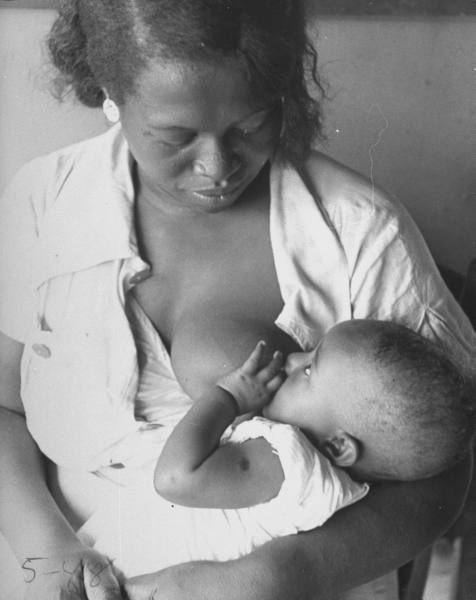 Breast milk contains enough water. Artificially fed babies need water.
Breast milk contains enough water. Artificially fed babies need water. 










